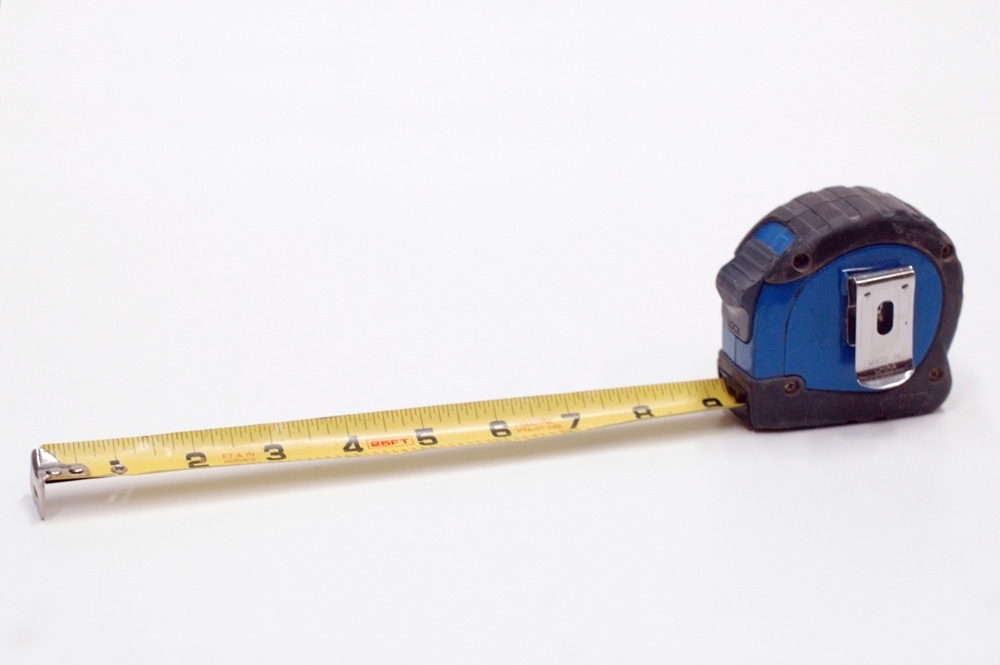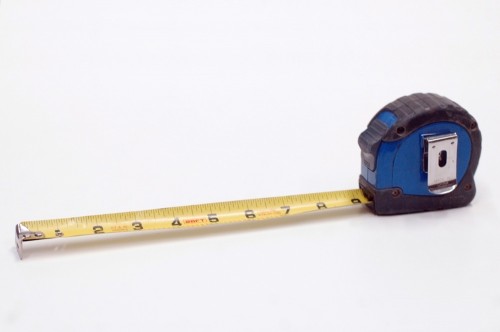Suppose you want to divide one foot into four parts: that is three inches. Divide a foot into three parts and you have four inches. Divide a meter into four parts: each part is 25 centimeters. Divide it into three parts and you are left with 33.33… cm.
The same is true with liquid and dry measurements. Take a cup. Now double it and you have a pint. Double it again and you have a quart. Take a gallon and divide in four; that’s a quart. Divide a liter into four parts, and you have to call it either 2.5 deciliters or 250 centiliters.
Look at a clock; it has sixty seconds in every minute, and sixty minutes in every hour. You can divide a minute in half, thirds, quarters, fifths, or sixths and in every case, you are left with a whole number of seconds. No fractions or decimals.
Metric may be good for scientific and technical measurements with things that increase by orders of magnitude. For example, hard drive memory started out with bytes, than kilobytes, followed by megabytes, gigabytes and now terabytes. But when dealing with carpentry and recipes and other measurements used in the construction of props, you are not having to convert between units which are one hundred or one thousand times larger than other units. You are dividing things into halves and quarters and thirds. You want to be able to take a measurement with a ruler which gives you one or two whole numbers and a fraction. It is so much easier to say “this prop is one foot and three inches tall, two feet and five inches long, and three quarters of an inch thick” than it is to say “this prop is 38.1 centimeters tall, 73.7 centimeters long, and 19 millimeters thick.” Furthermore, when you look at a tape measure, the hash marks for the fractions of an inch are all different sizes, so you can easily see whether you are at 1/4 or 5/16. With a metric tape measure, you have ten tiny divisions per centimeter, all at the same height. Is that .7 cm or .8? Who knows! (Of course, the greatest sin is a tape measure with both metric and customary units.)
The system of inches and feet were developed from commonly experienced physical objects, like a human thumb and a human foot. Their subdivisions were developed to measure commonly constructed objects for everyday use. This is what we deal with in props; the construction of everyday items on a human scale. A meter, on the other hand, was derived as a fraction of the Earth’s diameter. How much more sense does it make to say “this bench should be as long as three of my feet” than it is to say “this bench should be large enough so that 3,187,000 of them will fit end-to-end from one side of the planet to the other, going through the center”? Balderdash!
Metric is a centrally-designed hierarchical system which is applied to the measurement of everything conceivable, while customary units are a collection of localized systems specifically altered to the items and entities being measured. It may be funny to dig up archaic names of measurements to ask rhetorical questions like “how many hogsheads in a morgen”. In reality though, you will never need to convert the measurement of a cask of wine to the measurement for a plot of land. As an aside, archaic units are not limited to the customary system; does anyone in metric still use a stère?
It may be tricky to calculate how many inches are in a mile, but you rarely need to use that conversion in day-to-day life. Finally, despite the often touted ease of converting from nanograms to kilograms to megagrams, scientists have settled on essentially using the kilogram to measure the mass of everything, from the sun to an electron. No need to convert anything!
This is not so much a case against metric, but an appeal for hybrid systems and specificity in measurements to the task at hand. There is no harm done if I build a bench using inches and feet while biologists measure the volume of a cell in micrometers. I don’t wear the same outfit as a biologist, and a biologist doesn’t use the same tools and machines as a props artisan. That would be absurd. Neither of us have to convert the volume of a cell to the height of a chair. That would be even more absurd. Both of us using the same system of measurements? That’s the absurdest.







But… it isn’t really a fraction. You say you prefer 1 foot and 3 inches over 31.3 centimeters… but that could also be expressed as 31 centimeters and 3 millimeters. Fractional expression therefore removed.
The biggest reason Americans haven’t embraced metric is unfamiliarity. Those of us that work with it regularly can pretty accurately visualize a foot or a yard, but can’t do the same for a meter or 30 centimeters. If we could I think we’d much more readily accept metric.
I do agree that not having differentiated heights in the metric tick marks is an issue though. At least alternate evens and odds, with an extra tall one at 5mm.
It’s true that unfamiliarity with metric keeps many of us from using it, but that is not a reason to embrace it. We already have standardized units for science, industry, and trade, but that does not mean we need to extend those standardized units to every facet of our lives. We use the units of measurement which allow the clearest form of communication between two or more people. A football field is not a standard unit of measurement, but we routinely use “the length of a football field” as a way to describe distance.
A standardized, static system of measurements dictated from the top-down leaves little room for improvisation and evolution. Imagine if we fixed the titles of occupations in the 1890s and dictated that you can only describe your occupation using one of those titles even today. Computer programmers and web designers would have a hard time trying to decide if they are an accomptant or an enumerator.
Top-down systems imposed upon pre-existing cultures rarely work out well.
I’m all for using appropriate measures for the appropriate thing…. but…. as someone who grew up in a 100% metric country, even though I understand imperial measurement and can switch inches to centimetres no problems at all, I find metric far more accurate (well, easier to be accurate with). So I suspect it’s horses for courses and whatever you’re familiar with, rather than suggesting that metric couldn’t work for props.
Perhaps it’s a symptom of living in aforementioned metric country (Australia), but I’ve never seen a metric tape-measure WITHOUT an extended mark for the 5mm, and find that a much easier delineator than the plethora of marks that are there for all the part-inches on imperial tape measures. But again, whatever you’re comfortable with!
What I really like about the metric system is that it is so easy to calculate across things. I know a cubic centrimetre of water is a gram and that linear/weight conversion has helped with a number of jobs in the past. (Perhaps there’s an imperial equivalent and I just don’t know!)
Potayto, potahto, tomayto, tomahto – as long as the show doesn’t get called off!
As always, I love the conversations/thoughts this blog provokes!
“A pint’s a pound the world around!”
That’s what I learned.
I think my major point is that systems of measurement do not need to be so rigid and standardized. You can build props in Australia with metric and I can build props in the US with customary units, and neither of us are affected.
Occasionally, you have to work on a co-production, transfer or tour from another country, and everyone on the production team has to convert all the drawings from one system of measurement to the other. But for me, those situations are rare, and the time it takes to convert units is nothing compared to the time I save by working in a system of measurements which are ingrained in my brain.
Absolutely! Does your post mean there’s a move towards metric in the States? It never occurred to me that you would work in anything other than imperial.
I think the last major pushes fizzled out in the 90s. These days the push is more for voluntary use rather than with any specific legislation.
Great piece – couldn’t agree more. I lived in Canada during the switch-over from imperial to metric. Even though I’m familiar with metric, I much prefer inches, feet and pounds.
Interesting argument here. I grew up in Taiwan and I am used to centimeters and kilograms. It’s good for the mathematically minded. I think it works really well when we need to get a sense of scales. Whether you are going from millimeters to centimeters, meters, or kilometers, it’s always some kind of multiple of 10. Whereas if I am going from inches to feet, yards, and miles, I am multiplying by a factor of 12, 3, and so on. In that sense, it’s not all that intuitive to me. However, when I am making stuff, I sometimes do find it convenient to have this inch, half inch, quarter inch thing. And 12 (inches in a foot, hours in one revolution of the clock) is a number divisible by 2, 3, 4, 6, and 12 is a number good to use for dividing things up.
Funny how you mentioned bytes, kilobytes, and megabytes. It actually has the properties of a little bit of both. (I am a computer programmer, by the way.) Every measurement in computer science are in powers of 2. A byte is 2^3 = 8 bits.
1 kilobyte = 2^10 bytes = 1024 bytes
1 megabyte = 2^10 kilobytes = 2^20 bytes = 1048576 bytes
So, although we are using the words kilo and mega, we are talking about 1024, not 1000, and 1048576, not 1,000,000. So the units are different by a factor of precisely 2^10, but also roughly 10^3. So when we are not being that precise, pretending the units are different by a factor of 1000 is usually close enough. And of course, since it’s 2’s power for everything (since everything is just 0 and 1), it’s always easy to multiply and divide by 2 when we are using it to measure things.